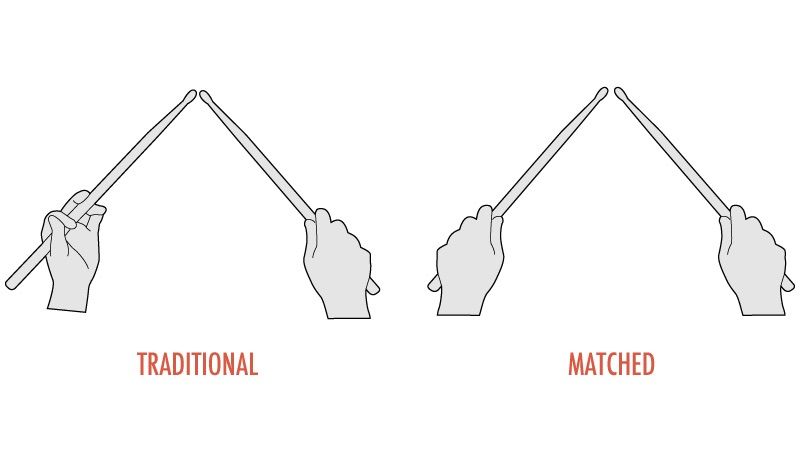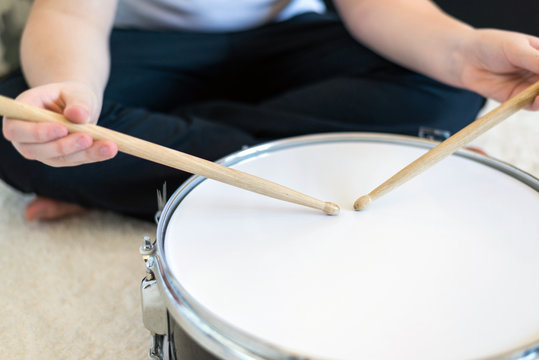Studying and learning different drum stick grips is certainly not the most amusing task a drummer can pursue, so why go through the hassle of comparing the French grip with the overhand grip?
What can be easy to overlook is that each drummer actually has a preferred grip which feels most comfortable to him behind the kit.
Perhaps drum stick grip was emphasized in one of those three drum lessons you took years ago, but now it is only an after-thought since, let’s be honest, there are way more flashy drumming topics at hand (no pun intended).
However, choosing the right grip is not merely for the beginner who just bought his first pair of sticks after the ones that came with his kit broke, but also for a player who has been playing for 20 years, or of youngers just starting and looking for the affordable drum sticks for kids.
Further, the way in which a player holds his drum sticks can provide a rather unique advantage in certain genres of music.
Whether a drummer finds himself pursuing a particular blast beat speed or he desires more fluidity in his ghost notes, drum stick grip is essential for every drummer’s groove, feel, and efficiency around the kit.
how to hold drum sticks youtube
This video compares and contrasts the matched and traditional grip. Both have their advantages, but it is important to determine which grip is right for you. See what is most comfortable for your style of drumming.
Here is another video that explores the difference between a middle and index finger fulcrum. Is “finger fulcrum” just a fancy way to say “hinge?”.
This is important to the drummer who desires speed and consistent power in each stroke.
In any case, if you lose your drum sticks ofter, you should consider getting one of the best drum stick bags you can find in the market. They are handy and will support you by having other sticks just there when you need them!
In this video, the finger fulcrum is further explored. Is finger fulcrum a grip, or is it a technique? This question along with others are addressed.
What is the wrong way to hold drumsticks?
This video emphasizes wrong and right ways to grip drum sticks. This is important to the drummer looking to utilize the best grip for his drumming style.
how to hold drum sticks properly and correctly
Although stick grip can be quite subjective to each drummer, there are, however, a few universal principles each drummer should acknowledge.
First, the grip mustn’t be too tight. In this case, a drum stick holder can help you get a new stick if you lose one while you are playing.
One of the worst things a drummer can do is hold the sticks too tightly. Not only does this cause fatigue in the hand muscles, but it can also interfere with the feel and rhythm.
So for instance, the more intense the grip applied to the stick the more tension from the arm is brought into the mix (pun absolutely intended).
The more the arms are involved the more difficult it will be to demonstrate efficiency, groove, and consistency around the kit.
The drum stick is your friend and its natural rebound, when used properly, helps the drummer work smarter – not harder. If you want to test it, place your drums sticks deep within your palms.
This almost immediately takes your wrist out of the equation which is not a happy occasion in the drumming world.
The more the wrists are involved the better.
Now, place the drum sticks in the first knuckles of your fingers. Your wrists are now able to be incorporated providing fluidity and power behind each stroke.
Here are a few pictures which demonstrate good, bad, and horrendous grip. Warning – the third picture may induce nightmares:
how to hold drum sticks matched grip
The two main categories of stick grip are matched and traditional grip. In a matched grip, the drum sticks are held the same way in both hands by the index finger and thumbs.
On the other hand (ok, pun intended), a traditional grip is when the stick is held by the dominant hand’s index finger and thumb.
The weaker hand, however, is held in between the middle and ring finger with the thumb overlaying the stick. You may have seen this grip in a marching setting. Pictured below is an example of each grip described above:

Matched grip
Aforementioned, matched grip is a grip matched (hence the name) between the two hands. They are positioned in the index finger and thumb.
This is a rather common option for modern drummers, and it is likely you have seen many drummers choose this particular grip. It has grown more popular over the years especially within the rock and metal genre.
This video provides an overview of what the matched grip is, and why it is applicable for certain drummers. What are the benefits and disadvantages of a matched grip?
See the video below:
German grip
The German grip is typically utilized for genres that emphasize speed.
The sticks are held at a 90-degree angle from each other. The thumbs are angled to the side.
This is a grip that allows the remaining fingers (middle, ring, and pinky) to take advantage of the stick rebound from the drum since both palms are facing downward. For instance, there is a strong possibility that a drummer playing a 250 BPM blast beat for 4 measures is utilizing this or the French technique.
In the video below, we see this grip explained in a more in-depth manner. Are you looking to improve your single stroke speed?
This grip is worth taking a look into.
American grip
The American grip is the “middle man” between the German and French grip.
The sticks should be aligned within the axis of each arm. This grip is a great way to make all the techniques available.
For instance, it permits the drum player to use all of his wrist (no fingers), all of his fingers (no wrist), and a combination between the two.
At the 1:04 mark in the video linked below, he gives an example of this. This grip is probably the most popular matched grip available. In spite of its simplicity, it is popular because of its versatility.
This grip can be seen in any genre from heavy metal to jazz, to pop.
Check out the video below for a thorough explanation of the American grip and its advantages.
French grip
The French grip is where the sticks are aligned with the thumbs in a parallel fashion all the way up the arm axis. So, the finger fulcrum is located at the thumb (facing upward) and the index finger wrapped around the stick.
The emphasis of this grip is the thumb at the top.
The remaining part of the stick should be resting in the first knuckles of the middle, ring, and pinky finger.
This is another grip used to induce stroke speed because it lets the drumstick rebound in a particular fashion controlled by the fingers remaining fingers.
This grip prevents the hand from having to be too mobile. The finger fulcrum is making the drumstick do most of the work which is, you guessed it, efficiency!
The video below is a simple explanation and demonstration of the French grip. See if this grip is a good option for you and your style of drumming:
Traditional grip
The traditional grip originated within the military marching drummers who needed their sticks to have the right amount of mobility to clear the drum rim.
Since their drums hung from their shoulders at a slant, they needed a grip which would be suitable for the specific angle of the hanging drum.
From that, we have what is now called the traditional grip. Although this grip has been around quite a while, it is still prevalent today in certain genres.
For instance, looking at any marching band, the majority of the marching snare drummers will be using a traditional grip. It can also be seen in the jazz genre.
This unique position of the stick in the weak hang can provide advantages and disadvantages. Perhaps the most practical advantage the traditional grip provides the drummer is a softer range of notes. This is especially applicable to drummers who use plenty of ghost notes and quiet strokes.
Not only does this grip increase feel, but it also requires less effort because the motion is more pull than push. However, this grip does limit stroke power in comparison to a matched grip.
The attached video below gives an overview of the traditional grip, what genres it is best applicable for, and how to begin using it.
how to hold drum sticks in jazz
Best drummers in jazz like to stick (no pun intended) with a traditional grip because of the extra feel it gives the drummer around the pocket.
Again, this grip is when the weak hand positions the drum stick in between the middle finger and ring finger while wrapping the thumb and index finger around the base of the stick.
Jazz is a genre that demands dynamics and grove from a drummer. With this, the drummer needs a grip he can rely on to play crispy ghost notes and fancy rudiments while also managing any fluctuating tempos.
The underhand grip of the weak hand can be a more effective method for any drummer looking to get a grip (sorry, the last pun, I think) of the technical demands of this particular genre.
This grip also gives the drummer plenty of opportunities to utilize the rebound of the drumstick from the drum head.
The underhand grip involves the wrist in a fashion way.



